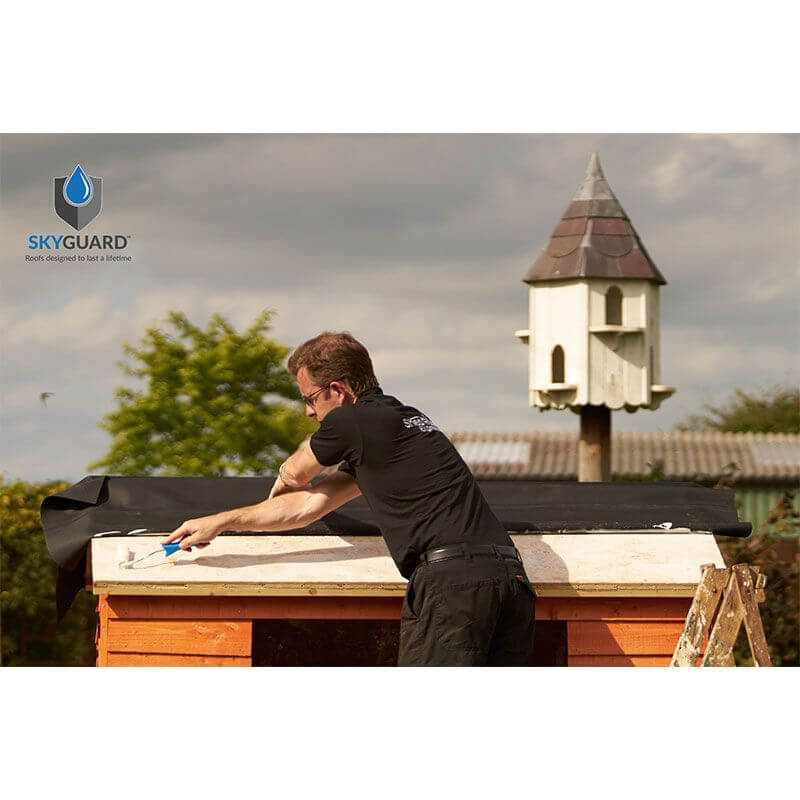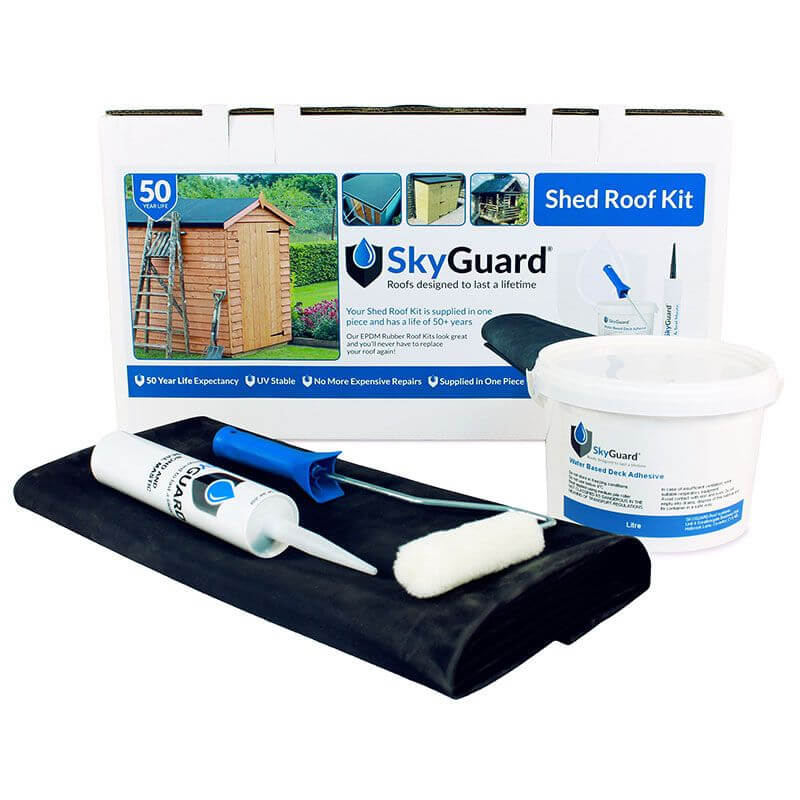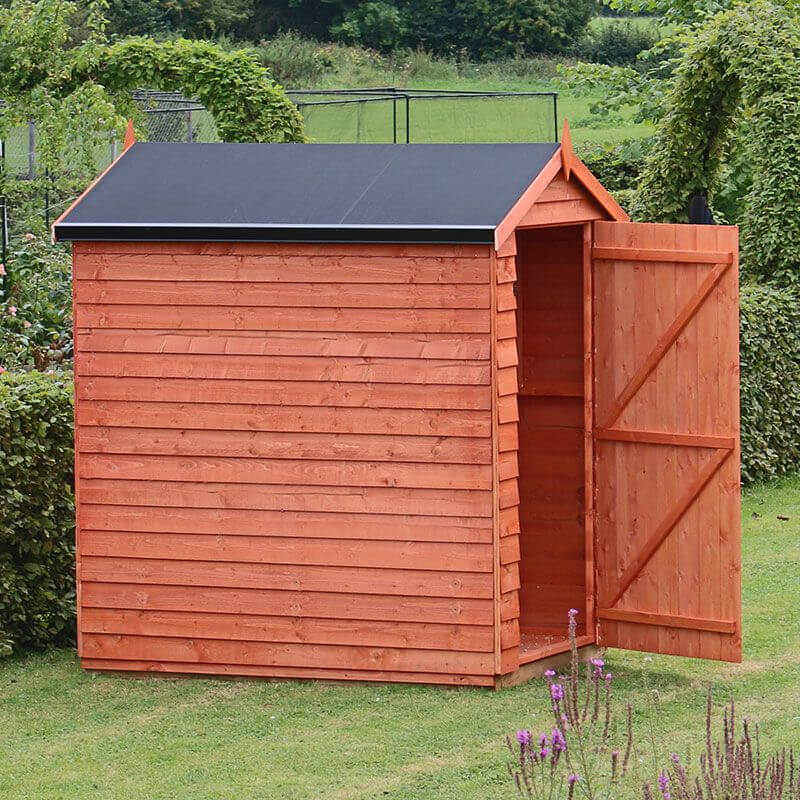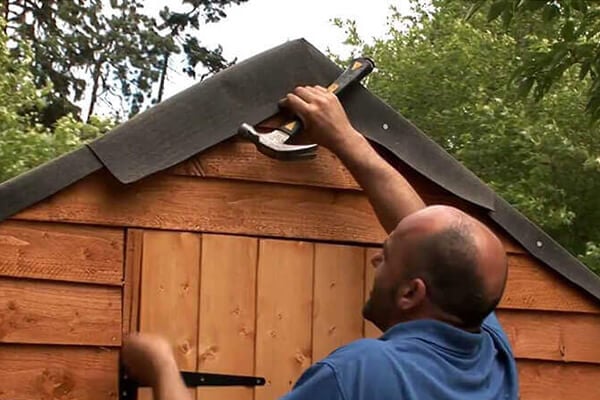
Shed roofing is a vital component of outdoor storage spaces, offering protection against the unpredictable British weather while enhancing the aesthetic appeal of your property. Shed roof felting is a time-tested roofing material, but with other options available like EPDM rubber roofing exploring the best shed roofing options is essential for a well-informed choice.
In this comprehensive guide, Shedstore explore various shed roofing materials, from traditional options like felt to modern alternatives like EPDM, metal, polycarbonate, and others. Join us as we explore the essential factors that influence this crucial decision and uncover the great debate between choosing EPDM or felt, along with other popular roofing materials in the UK.
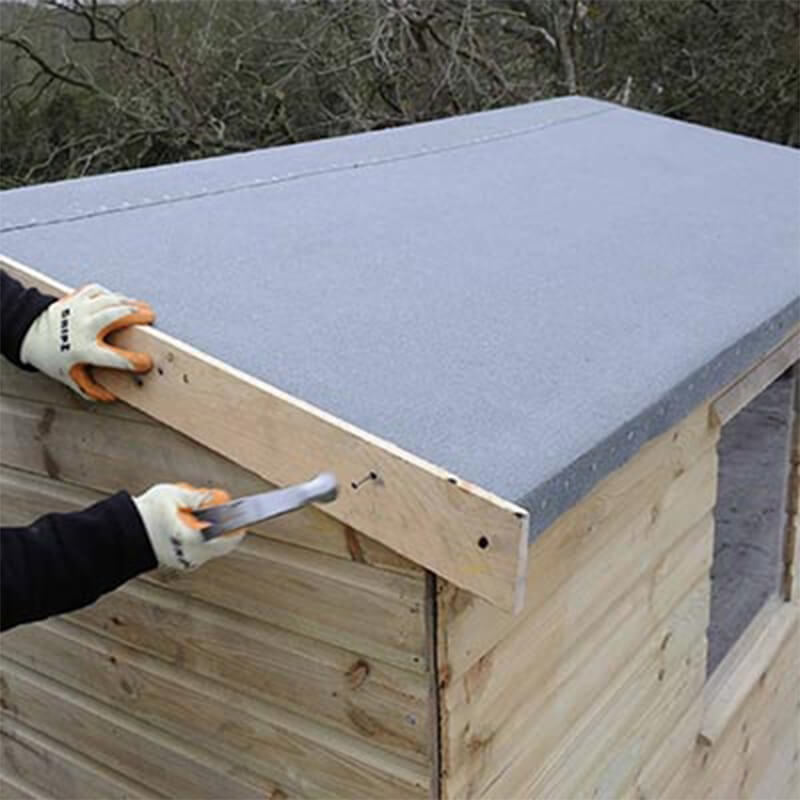

Introduction to shed roof felting
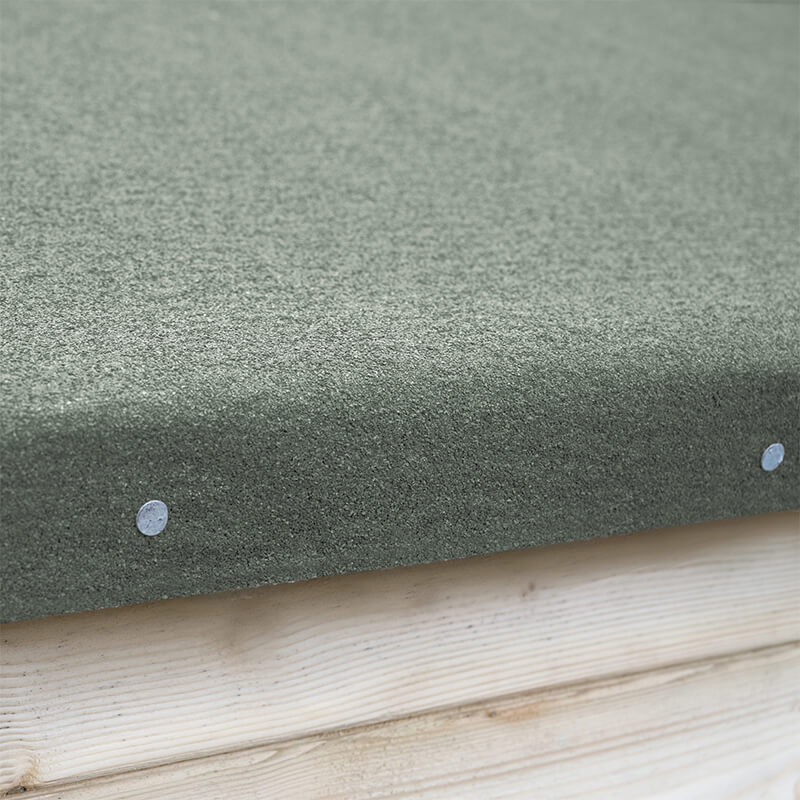

Shed roof felting, also sometimes known as asphalt or bitumen, is a versatile roofing material that has been in use for many decades. Shed felt roofing primarily consists of a base material saturated with asphalt or bitumen. The base material is typically made from organic materials like cellulose or fibreglass, or it can be a combination of both. The asphalt or bitumen saturates and waterproofs the base, providing the necessary weather resistance.
Traditionally, shed roof felting has been widely used in residential and commercial construction for its affordability and reliability. It has a long history of protecting structures from the elements and has adapted over the years to accommodate various roofing needs.
Exploring the best shed roofing options
Whether choosing felt, rubber EPDM, or another material, shed roofing holds significant importance because it shields your outdoor storage space from the worst of the British weather. Deciding on the right option will help to ensure the safety and protection of the items stored within while preventing structural damage over time. Additionally, a well-chosen shed roofing material can enhance the overall aesthetic appeal of your outdoor area.
Choosing from a variety of shed roofing options is crucial, as it allows you to tailor your selection to factors such as aesthetics, cost-effectiveness, durability, and various other considerations specific to your needs.
Read below as we continue exploring the best shed roofing materials and options to help you make an informed decision that suits your needs and preferences.
Top shed roofing materials
Other than shed felt, six of the most popular shed roofing materials are asphalt shingles, EPDM rubber, metal, polycarbonate, roll roofing, and wood shakes.
The EPDM vs felt roofing question is most frequently debated, but they’re not the only two materials available. Here we provide an overview of each of these to help you choose the best shed roofing material for your needs:
1) Asphalt shingles roofing
Asphalt shingles are one of the most popular and widely used roofing materials. They are composed of a fibreglass or organic mat saturated with asphalt and coated with granules. These shingles are known for their affordability, durability, and ease of installation. They are available in a variety of colours and styles, making them suitable for various architectural designs. Asphalt shingles provide reliable protection against weather elements and have a moderate lifespan of 20-30 years, depending on climate conditions.
2) EPDM rubber roofing
EPDM (Ethylene Propylene Diene Monomer) roofing is a synthetic rubber material, which is renowned for its outstanding durability in the face of weathering. It is commonly used for low-slope and flat roofs due to its waterproofing properties. EPDM roofing is easy to install and maintain, and it typically has a lifespan of 30-50 years. It is highly resistant to UV radiation and ozone, making it a highly sought-after choice for long-term roofing solutions.
3) Metal roofing
Metal roofing materials, such as steel, aluminium, or copper, provide outstanding longevity and strength. They are known for their resistance to extreme weather conditions, including heavy rain, snow, and hail. Metal roofs are available in various styles, including standing seam panels and metal shingles. They are lightweight, fire-resistant, and eco-friendly due to their recyclability. Metal roofs can last 50 years or more, making them a cost-effective, long-term roofing choice.
4) Polycarbonate roofing
Polycarbonate roofing consists of transparent or translucent panels made from polycarbonate sheets. It is often used to maximise natural light in sheds or other outdoor structures. Polycarbonate panels are lightweight and easy to install. They provide protection from rain and UV radiation while allowing diffused sunlight to pass through. This roofing type is favoured for its aesthetic appeal and energy-efficient properties, making it ideal for greenhouses, sunrooms, and covered outdoor spaces.
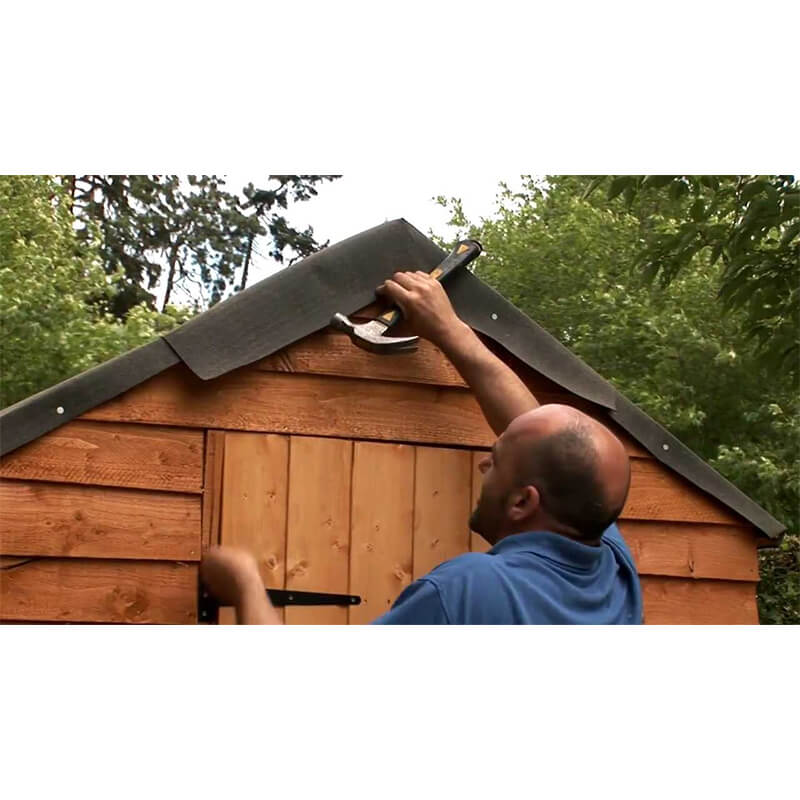

5) Roll roofing
Roll roofing, also known as mineral-surfaced roofing or felt roofing, is a cost-effective roofing material. It is typically used on low-slope or flat roofs and is made of asphalt-impregnated felt or fibreglass. Roll roofing is easy to install in large rolls, making it a suitable choice for sheds and small outbuildings. While it may have a shorter lifespan compared to some other roofing materials, it provides basic protection against the elements at an affordable price point.
6) Wood shakes roofing
The final in our list of shed roofing options, wood shakes roofing is a traditional roofing material made from split wooden logs. It is valued for its natural and rustic appearance, adding, for example, charm to garden sheds and log cabins. Wood shakes are environmentally friendly and biodegradable. They offer decent insulation and can last 20-40 years when properly maintained. However, they require regular maintenance, including sealing and periodic replacement of damaged shakes, to prevent issues like rot and pests.
EPDM vs felt roofing - The great debate
In the United Kingdom, the choice between EPDM and shed felt roofing materials has sparked a substantial debate among builders and homeowners. EPDM or felt come with their own set of advantages and drawbacks, making it essential to scrutinise the key aspects of both materials to make an informed decision.
Why is this such a debate?
The ongoing debate surrounding EPDM and felt roofing materials in the UK can be attributed to the diverse roofing needs, climate conditions, and budget considerations of property owners. Understanding the nuances of this debate requires a comprehensive analysis of the features that distinguish these materials from one another. Below, we provide a detailed comparison of the key characteristics of EPDM vs felt roofing to shed light on why this is a lively debate.
EPDM or felt features
To unravel the intricacies of the EPDM vs felt roofing debate, we present a comprehensive features table below. This table highlights the key features that property owners and builders commonly consider when selecting a roofing material. For each feature, we evaluate the compliance of both EPDM and felt, providing a side-by-side comparison of their performance in various aspects.
| # |
Feature |
EPDM |
Felt |
| 1 |
Aesthetic options |
Limited |
Varied |
| 2 |
Application range |
Low-Slope/Flat |
Low-Slope/Flat |
| 3 |
Cost-effectiveness |
Moderate |
High |
| 4 |
Durability |
High |
Moderate |
| 5 |
Ease of installation |
Moderate |
Easy |
| 6 |
Environmental friendliness |
Moderate |
Moderate |
| 7 |
Environmental impact |
Moderate |
Moderate |
| 8 |
Fire resistance |
High |
Moderate |
| 9 |
Guarantee options |
Available |
Limited |
| 10 |
Installation skill required |
Moderate |
Easy |
| 11 |
Insulation properties |
Excellent |
Fair |
| 12 |
Lifespan |
30-50 years |
10-20 years |
| 13 |
Maintenance requirements |
Low |
Moderate |
| 14 |
Recyclability |
Yes |
Yes |
| 15 |
Resistance to pests |
High |
Moderate |
| 16 |
Resistance to ponding water |
Excellent |
Moderate |
| 17 |
Sound insulation |
Good |
Moderate |
| 18 |
UV radiation resistance |
Excellent |
Moderate |
| 19 |
Weather resistance |
Excellent |
Good |
| 20 |
Weight on roof structure |
Lightweight |
Lightweight |
| 21 |
Material and supplies cost estimate |
£15-£35/m2 |
£10-£25/m2 |
| 22 |
Professional installation cost estimate |
£80-£150 |
£80-£150 |
| 23 |
Lifetime cost estimate over 50 years |
£300 |
£520 |
The installation and lifetime costs assume an 10x8 shed size with professionally installed roof and a life expectancy of 20 years for felt and 50 years for EPDM.
Summary
This comprehensive comparison table underscores the critical factors influencing the EPDM vs. felt roofing debate in the UK. EPDM roofing stands out with its superior durability, weather resistance, and lifespan, making it a robust choice for long-term protection against the UK's unpredictable climate. However, it has a moderate cost and requires more skill during installation.
Shed felt roofing, on the other hand, offers budget-friendly options with easy installation but has a shorter lifespan and fewer advantages in terms of durability and weather resistance.
Property owners must carefully weigh these features to make an informed decision for their specific roofing needs and budget constraints.
Last words
In conclusion, shed roof felting, remains a versatile and trusted roofing material with a rich history of providing reliable protection for various structures. While it has been a staple choice, the exploration of alternative shed roofing options like EPDM is essential.
Shed roofing plays a pivotal role in safeguarding outdoor storage spaces from the UK's challenging weather conditions while enhancing their aesthetic appeal. Whether opting for traditional materials like felt or considering modern alternatives such as EPDM, metal, or polycarbonate, a thoughtful selection to determine the best shed roofing material is crucial.
The great debate between EPDM vs felt roofing materials in the UK highlights the importance of thoroughly evaluating their unique features to match specific needs and preferences. The comprehensive features table presented above offers valuable insights to assist buyers of roofing in making informed decisions for their shed roofing projects.
Drop us a line
Explore vital garden shed roofing options in our extensive guide, covering the best shed roofing materials and options. Whether you are considering shed roof felting or debating between EPDM or felt roofing, our team can help provide valuable advice on materials, replacement steps, and the pros and cons of each choice.
For expert assistance, contact us at Shedstore through the following methods:
- Call 0333 003 0518
- Emails – using our contact page
- Chat - using the live chat app





